Recycling Aggregates for Self-Compacting Concrete Production: A Feasible Option
Abstract
1. Introduction
2. Materials and Methods
2.1. Materials
2.1.1. Paste
2.1.2. Aggregates
Composition and Characterization of the Recycled Aggregates
Composition and Characterization of the Natural Coarse and Fine Aggregates
2.1.3. Superplasticizer Additive
2.1.4. Water
2.2. Compositions
2.3. Mixing Protocol
3. Results and Discussion
3.1. Assessment of Coarse Recycled Aggregate
3.2. Composition
3.3. Self-Compactability
- -
- Based on the flow class: Class AC-E1,
- -
- Based on the viscosity class: AC-V1,
- -
- Based on the blocking resistance class: AC-RB2.
3.4. Compressive Strength
3.5. Tensile Strength
3.6. Flexural Strength
4. Conclusions
- It is feasible to achieve an SCC with recycled aggregates. SCC was produced with this C&DW as aggregate in the proportions recommended by EHE-08 of 20% substitution and above 50% and 100% with minimal loss in the properties. The SP content needs to be increased as RCA content increases, so CC concrete contains 0.8% of the weight cement, Mix 20 contains 1%, Mix 50 contains 1.2%, and Mix 100 contains 1.35%,
- The aggregates studied showed characteristics within the limits established by EHE-08 for recycled aggregates, a large quantity of concrete (71%) and natural stone (27%) in composition and a low proportion of ceramic, which means absorption is not penalized and it is within the limits allowed by the standard,
- The consistency of recycled aggregate mixes is not significantly affected by adding coarse recycled aggregates and it shows adequate workability. The slump flow increases with the CRA incorporation ratio due to the gradual increase in SP content,
- The compressive strength is excellent and coherent with the composition used when producing concrete and is completely feasible for use in structural elements. The compressive strength increases with the CRA incorporation ratio. Mix 20 has 20% more strength than CC and Mix 50 about 18%. Only the total replacement mix, Mix 100, suffered a small drop in compressive strength, 5% less than the CC,
- Tensile strength decreases with the replacement of CNA with CRA by 12.71%, 31.25% and 30.60% in the mixes with CRA ratios 20%, 50% and 100% respectively. Regarding flexural strength, recycled aggregates concrete mixes did not show a notable difference with respect to CC. The values are almost constant, and hardly suffer a variation of 4%,
- The good self-compactability, mechanical resistance and durability results obtained should be an incentive to reconsider the use of this type of waste as recycled aggregates in concrete, which would also help make the construction process more sustainable.
- Readjusting the percentage of SP in some of the mixes, especially in Mix 20,
- Partial or total replacement of FRA (fine recycled aggregates) in the mixes,
- Microscopy and durability studies of the resulting concrete.
Author Contributions
Funding
Acknowledgments
Conflicts of Interest
References
- Eurostat. Recycling Rate of Waste Excluding Major Mineral Wastes. Available online: https://ec.europa.eu/eurostat/tgm/refreshTableAction.do?tab=table&plugin=1&pcode=ten00106&language=en (accessed on 24 April 2019).
- Eusrostat. Generation of Waste by Economic Activity. Available online: https://ec.europa.eu/eurostat/tgm/refreshTableAction.do?tab=table&plugin=1&pcode=ten00106&language=en (accessed on 3 December 2019).
- Anefa. Informe de Situación Económica Sectorial; Eurostat: Madrid, Spain, 2018. [Google Scholar]
- Evangelista, L.; de Brito, J. Mechanical Behaviour of Concrete Made with Fine Recycled Concrete Aggregates. Cem. Concr. Compos. 2007, 29, 397–401. [Google Scholar] [CrossRef]
- Tabsh, S.W.; Abdelfatah, A.S. Influence of Recycled Concrete Aggregates on Strength Properties of Concrete. Constr. Build. Mater. 2009, 23, 1163–1167. [Google Scholar] [CrossRef]
- Juan-Valdés, A.; Rodríguez-Robles, D.; García-González, J.; Guerra-Romero, M.I.; Morán-del Pozo, J.M. Mechanical and Microstructural Characterization of Non-Structural Precast Concrete Made with Recycled Mixed Ceramic Aggregates from Construction and Demolition Wastes. J. Clean. Prod. 2018, 180, 482–493. [Google Scholar] [CrossRef]
- Pacheco, J.; de Brito, J.; Chastre, C.; Evangelista, L. Experimental Investigation on the Variability of the Main Mechanical Properties of Concrete Produced with Coarse Recycled Concrete Aggregates. Constr. Build. Mater. 2019, 201, 110–120. [Google Scholar] [CrossRef]
- Mas, B.; Cladera, A.; Del Olmo, T.; Pitarch, F. Influence of the Amount of Mixed Recycled Aggregates on the Properties of Concrete for Non-Structural Use. Constr. Build. Mater. 2012, 27, 612–622. [Google Scholar] [CrossRef]
- Etxeberria, M.; Vázquez, E.; Marí, A.; Barra, M. Influence of Amount of Recycled Coarse Aggregates and Production Process on Properties of Recycled Aggregate Concrete. Cem. Concr. Res. 2007, 37, 735–742. [Google Scholar] [CrossRef]
- Rodríguez-Robles, D.; García-González, J.; Juan-Valdés, A.; Morán-del Pozo, J.M.; Guerra-Romero, M.I. Effect of Mixed Recycled Aggregates on Mechanical Properties of Recycled Concrete. Mag. Concr. Res. 2015, 67, 247–256. [Google Scholar] [CrossRef]
- Güneyisi, E.; Gesoglu, M.; Algın, Z.; Yazıcı, H. Effect of Surface Treatment Methods on the Properties of Self-Compacting Concrete with Recycled Aggregates. Constr. Build. Mater. 2014, 64, 172–183. [Google Scholar] [CrossRef]
- Herbudiman, B.; Saptaji, A.M. Self-Compacting Concrete with Recycled Traditional Roof Tile Powder. Procedia Eng. 2013, 54, 805–816. [Google Scholar] [CrossRef]
- González-Taboada, I.; González-Fonteboa, B.; Eiras-López, J.; Rojo-López, G. Tools for the Study of Self-Compacting Recycled Concrete Fresh Behaviour: Workability and Rheology. J. Clean. Prod. 2017, 156, 1–18. [Google Scholar] [CrossRef]
- Esquinas, A.R.; Ramos, C.; Jiménez, J.R.; Fernández, J.M.; de Brito, J. Mechanical Behaviour of Self-Compacting Concrete Made with Recovery Filler from Hot-Mix Asphalt Plants. Constr. Build. Mater. 2017, 131, 114–128. [Google Scholar] [CrossRef]
- Carro-López, D.; González-Fonteboa, B.; Martínez-Abella, F.; González-Taboada, I.; De Brito, J.; Varela-Puga, F. Proportioning, Microstructure and Fresh Properties of Self-Compacting Concrete with Recycled Sand. Procedia Eng. 2017, 171, 645–657. [Google Scholar] [CrossRef]
- Silva, P.; de Brito, J. Experimental Study of the Mechanical Properties and Shrinkage of Self-Compacting Concrete with Binary and Ternary Mixes of Fly Ash and Limestone Filler. Eur. J. Environ. Civ. Eng. 2017, 21, 430–453. [Google Scholar] [CrossRef]
- Santos, S.A.; da Silva, P.R.; de Brito, J. Mechanical Performance Evaluation of Self-Compacting Concrete with Fine and Coarse Recycled Aggregates from the Precast Industry. Materials 2017, 10, 904. [Google Scholar] [CrossRef]
- Esquinas, A.R.; Álvarez, J.I.; Jiménez, J.R.; Fernández, J.M.; de Brito, J. Durability of Self-Compacting Concrete Made with Recovery Filler from Hot-Mix Asphalt Plants. Constr. Build. Mater. 2018, 161, 407–419. [Google Scholar] [CrossRef]
- Carro-López, D.; González-Fonteboa, B.; Martínez-Abella, F.; González-Taboada, I.; de Brito, J.; Varela-Puga, F. Proportioning, Fresh-State Properties and Rheology of Self-Compacting Concrete with Fine Recycled Aggregates. Hormigón y Acero 2018, 69, 213–221. [Google Scholar] [CrossRef]
- Ghalehnovi, M.; Roshan, N.; Hakak, E.; Shamsabadi, E.A.; de Brito, J. Effect of Red Mud (Bauxite Residue) as Cement Replacement on the Properties of Self-Compacting Concrete Incorporating Various Fillers. J. Clean. Prod. 2019, 240, 118213. [Google Scholar] [CrossRef]
- Pereira-de-Oliveira, L.A.; Nepomuceno, M.C.S.; Castro-Gomes, J.P.; Vila, M.F.C. Permeability Properties of Self-Compacting Concrete with Coarse Recycled Aggregates. Constr. Build. Mater. 2014, 51, 113–120. [Google Scholar] [CrossRef]
- Safiuddin, M.; Salam, M.A.; Jumaat, M.Z. Effects of Recycled Concrete Aggregate on the Fresh Properties of Self-Consolidating Concrete. Arch. Civ. Mech. Eng. 2011, 11, 1023–1041. [Google Scholar] [CrossRef]
- Kebaïli, O.; Mouret, M.; Arabi, N.; Cassagnabere, F. Adverse Effect of the Mass Substitution of Natural Aggregates by Air-Dried Recycled Concrete Aggregates on the Self-Compacting Ability of Concrete: Evidence and Analysis through an Example. J. Clean. Prod. 2015, 87, 752–761. [Google Scholar] [CrossRef]
- Khaleel, O.R.; Abdul Razak, H. Mix Design Method for Self Compacting Metakaolin Concrete with Different Properties of Coarse Aggregate. Mater. Des. 2014, 53, 691–700. [Google Scholar] [CrossRef]
- Nieto, D. Estudio de Hormigón Autocompactante Con Árido Reciclado; Universidad Politécnica de Madrid: Madrid, Spain, 2015. [Google Scholar]
- Iglesias Oria, R. Hormigón Autocompactante Mejorado Con Aditivos Químicos y Uso de Áridos Reciclados; Universidad de Cantabria: Cantabria, Spain, 2012. [Google Scholar]
- Santos, S.; da Silva, P.R.; de Brito, J. Self-Compacting Concrete with Recycled Aggregates–A Literature Review. J. Build. Eng. 2019, 22, 349–371. [Google Scholar] [CrossRef]
- Grdic, Z.J.; Toplicic-Curcic, G.A.; Despotovic, I.M.; Ristic, N.S. Properties of Self-Compacting Concrete Prepared with Coarse Recycled Concrete Aggregate. Constr. Build. Mater. 2010, 24, 1129–1133. [Google Scholar] [CrossRef]
- Tuyan, M.; Mardani-aghabaglou, A.; Ramyar, K. Freeze–Thaw Resistance, Mechanical and Transport Properties of Self-Consolidating Concrete Incorporating Coarse Recycled Concrete Aggregate. Mater. Des. 2014, 53, 983–991. [Google Scholar] [CrossRef]
- Modani, P.O.; Mohitkar, V.M. Self-Compacting Concrete with Recycled Aggregate: A Solution for Sustainable Development. Int. J. Civ. Struct. Eng. 2014, 4, 430–440. [Google Scholar]
- EHE-08. Instrucción de Hormigón Estructural. Ministerio de Fomento: España. Available online: https://www.fomento.gob.es/organos-colegiados/mas-organos-colegiados/comision-permanente-del-hormigon/cph/instrucciones/ehe-08-version-en-castellano (accessed on 8 May 2019).
- Ouchi, M.; Hibino, M.; Okamura, H. Effect of Superplasticizer on Self-Compactability of Fresh Concrete. Transp. Res. Rec. 1997, 1574, 37–40. [Google Scholar] [CrossRef]
- Pereira-de Oliveira, L.A.; Nepomuceno, M.; Rangel, M. An Eco-Friendly Self-Compacting Concrete with Recycled Coarse Aggregates. Inf. Construcción 2013, 65, 31–41. [Google Scholar] [CrossRef]
- Available online: http://www.hormigonespecial.com/~pdfs/MONOGRAFIA_RECICLADO.pdf (accessed on 13 February 2020).
- Señas, L.; Priano, C.; Marfil, S. Influence of Recycled Aggregates on Properties of Self-Consolidating Concretes. Constr. Build. Mater. 2016, 113, 498–505. [Google Scholar] [CrossRef]
- González Taboada, I.; González Fonteboa, B.; Martínez Abella, F.; Rojo López, G. Influencia de Las Variaciones En Los Materiales Sobre La Reología de Hormigones Autocompactantes Reciclados. In V Congreso Iberoamericano de Hormigón Autocompactante y Hormigones Especiales; València de, E.U.P., Ed.; Polytechnic University of Valencia: Valencia, Spain, 2018. [Google Scholar] [CrossRef]
- Guerrero Vilches, I.M.; Rodriguez Jeronimo, G.; Rodriguez Montero, J. Valorización Como Árido Reciclado Mixto de Un Residuo de Construcción y Demolición En La Confección de Hormigones Autocompactantes Durables En Terrenos Con Yesos. In HAC2018-V Congreso Iberoamericano de Hormigón Autocompactante y Hormigones Especiales; Llano-Torre, A., Martí-Vargas, J.R., Ros, P.S., Eds.; Polytechnic University of Valencia: Valencia, Spain, 2018. [Google Scholar] [CrossRef]
- Okamura, H.; Ouchi, M. Self-Compacting Concrete. J. Adv. Concr. Technol. 2003, 1, 5–15. [Google Scholar] [CrossRef]
- UNE-EN 197-1:2013. Cemento. Parte 1: Composición, Especificaciones y Criterios de Confromidad de Los Cementos Comunes; Aenor: Madrid, España, 2013.
- UNE-EN 933-11:2009. Ensayos Para Determinar Las Propiedades Geométricas de Los Áridos. Parte 11: Ensayo de Clasificación de Los Componentes de Los Áridos Gruesos Reciclados; Aenor: Madrid, España, 2009.
- UNE-EN 933-1:2012. Ensayos Para Determinar Las Propiedades Geométricas de Los Áridos. Parte 3: Determinación de La Forma de Las Partículas. Índice de Lajas; Aenor: Madrid, España, 2012.
- UNE-EN 933-3:2012. Ensayos Para Determinar Las Propiedades Geométricas de Los Áridos. Parte 1: Determinación de La Granulometría de Las Partículas. Método Del Tamizado; Aenor: Madrid, España, 2012.
- UNE-EN 1097-6:2014. Ensayos Para Determinar Las Propiedades Mecánicas y Físicas de Los Áridos. Parte 6: Determinación de La Densidad de Partículas y La Absorción de Agua; Aenor: Madrid, España, 2014.
- UNE-EN 1097-2:2010. Ensayos Para Determinar Las Propiedades Mecánicas y Físicas de Los Áridos. Parte 2: Métodos Para La Determinación de La Resistencia a La Fragmentación; Aenor: Madrid, España, 2010.
- UNE-EN 12390-2:2009 Ensayos de Hormigón Endurecido. Parte 2: Fabricación y curado de probetas para ensayos de resistencia; Aenor: Madrid, España, 2009.
- UNE-EN 12350-8:2011. Ensayos de Hormigón Fresco. Parte 8: Hormigón Autocompactante; Aenor: Madrid, España, 2011.
- UNE-EN 12350-12:2011. Ensayos de Hormigón Fresco. Parte 12: Hormigón Autocompactante. Ensayo Con El Anillo Japonés; Aenor: Madrid, España, 2011.
- UNE-EN 12390-3:2009 Ensayos de Hormigón Endurecido. Parte 3: Determinación de La Resistencia a Compresión de Probetas; Aenor: Madrid, España, 2009.
- UNE-EN 12390-6:2010. Ensayos de Hormigón Endurecido. Parte 6: Resistencia a Tracción Indirecta de Probetas; Aenor: Madrid, España, 2010.
- UNE-EN 12390-5:2009. Ensayos de Hormigón Endurecido. Parte 5: Resistencia a Flexión de Probetas; Aenor: Madrid, España, 2009.
- Okamura, H.; Ouchit, M. Self-Compacting High Performance Concrete Development of Self-Compacting Concrete. Prog. Struct. Mater. Eng. 1998, 1, 378–383. [Google Scholar] [CrossRef]
- García González, J. Concrete with Ceramic Mixed Construction and Demolition Waste: Optimization of Physical, Mechanical and Durability Properties by Aggregate Pre-Saturation, Use of Superplasticizers and Microbially Induced Carbonate Precipitation. Ph.D. Thesis, University of Ghent, Ghent, Belgium, 2016. [Google Scholar]
- EFNARC. Specification and Guidelines for Self-Compacting Concrete. Rep. EFNARC 2002, 44, 32. [Google Scholar]

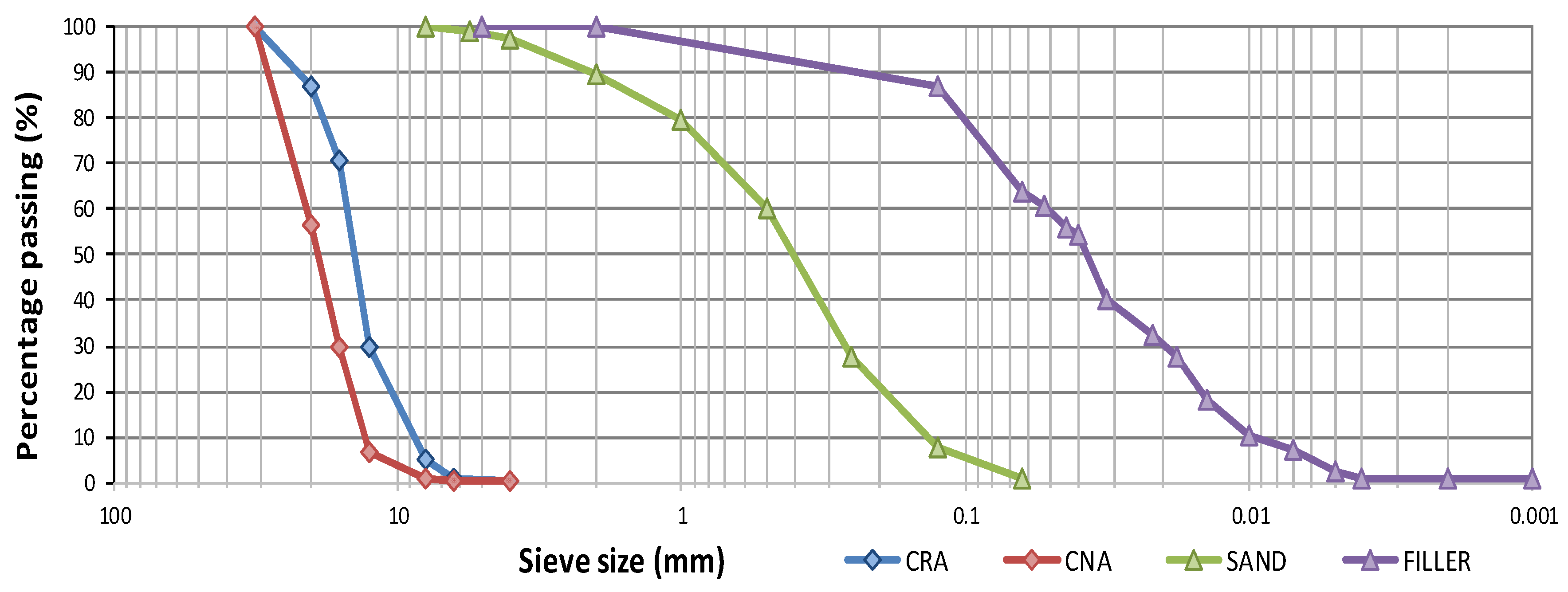

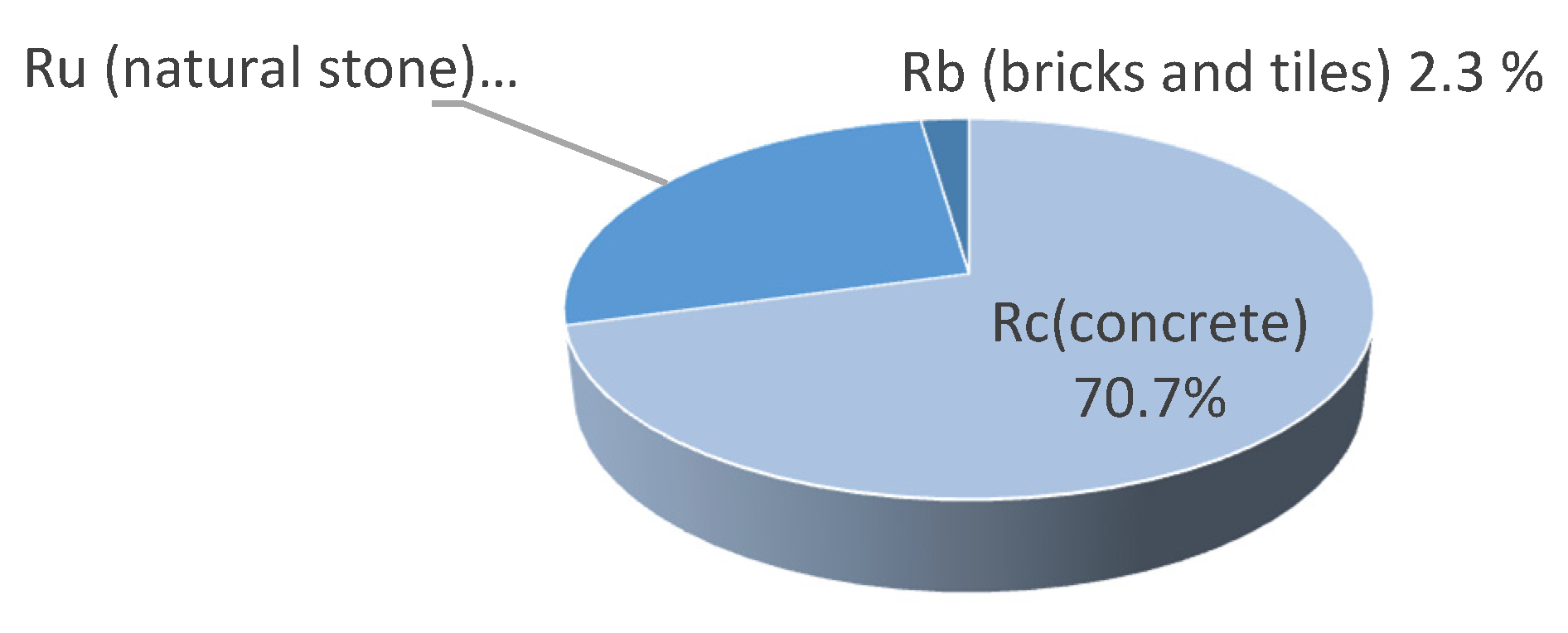


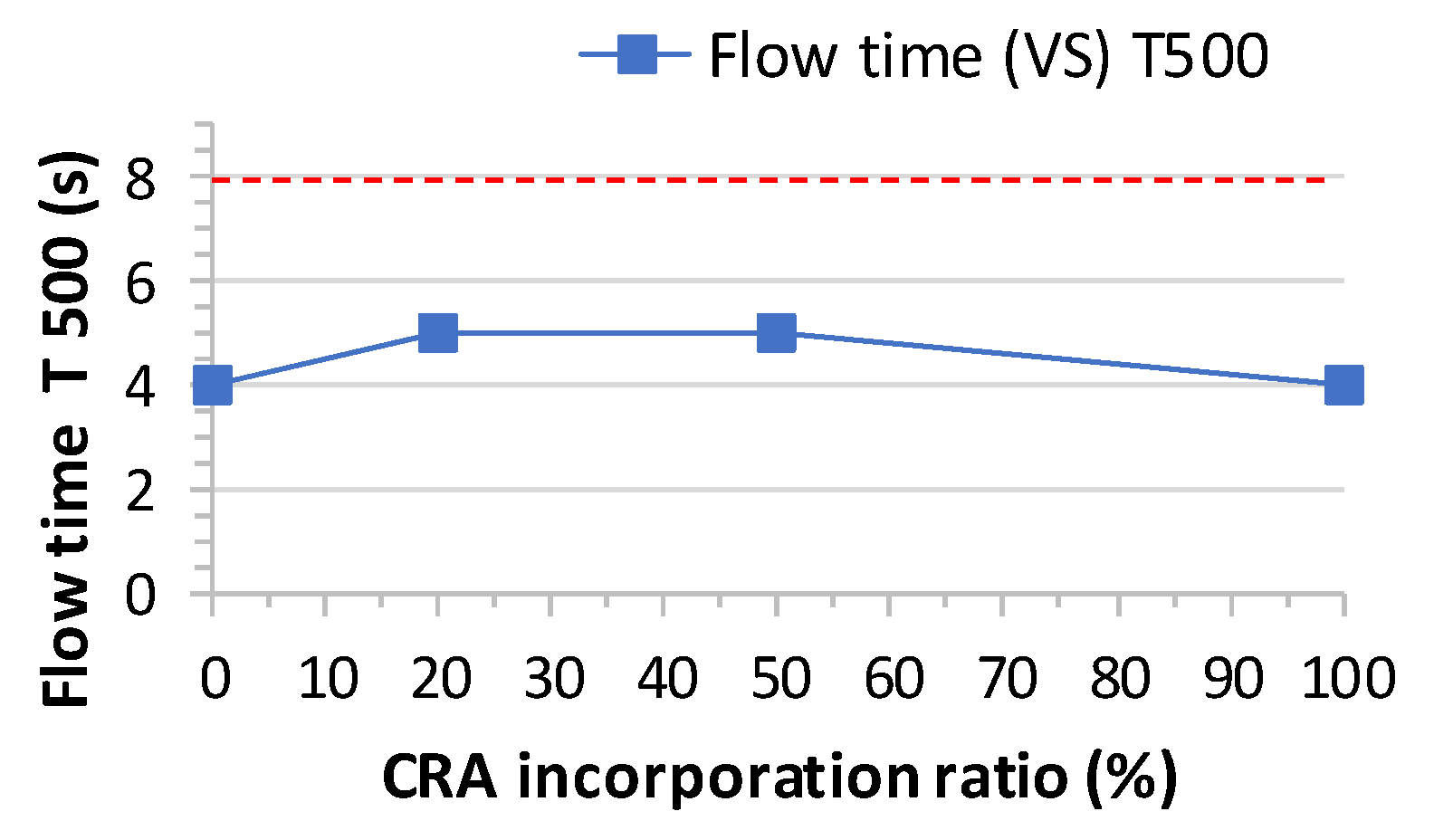

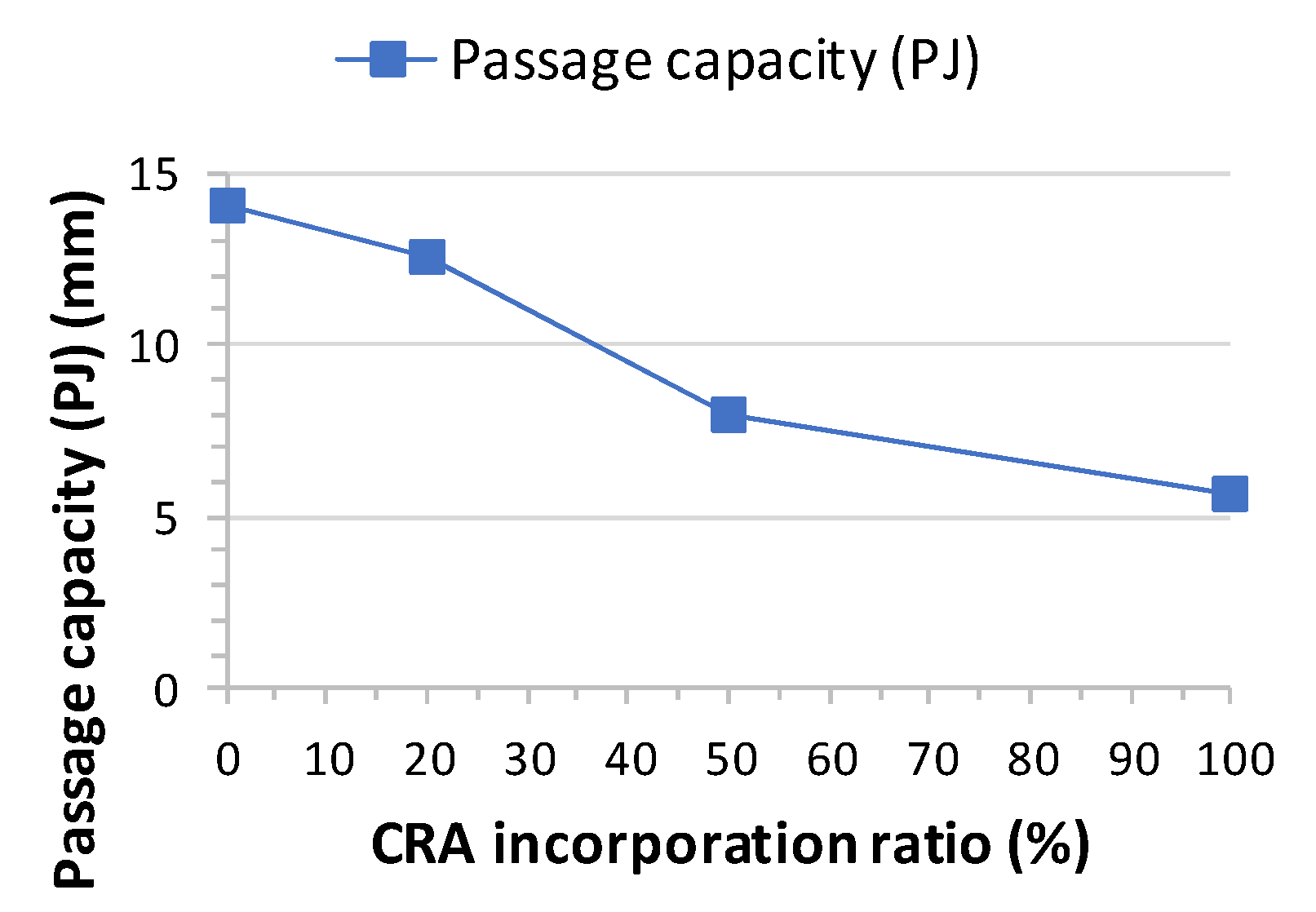
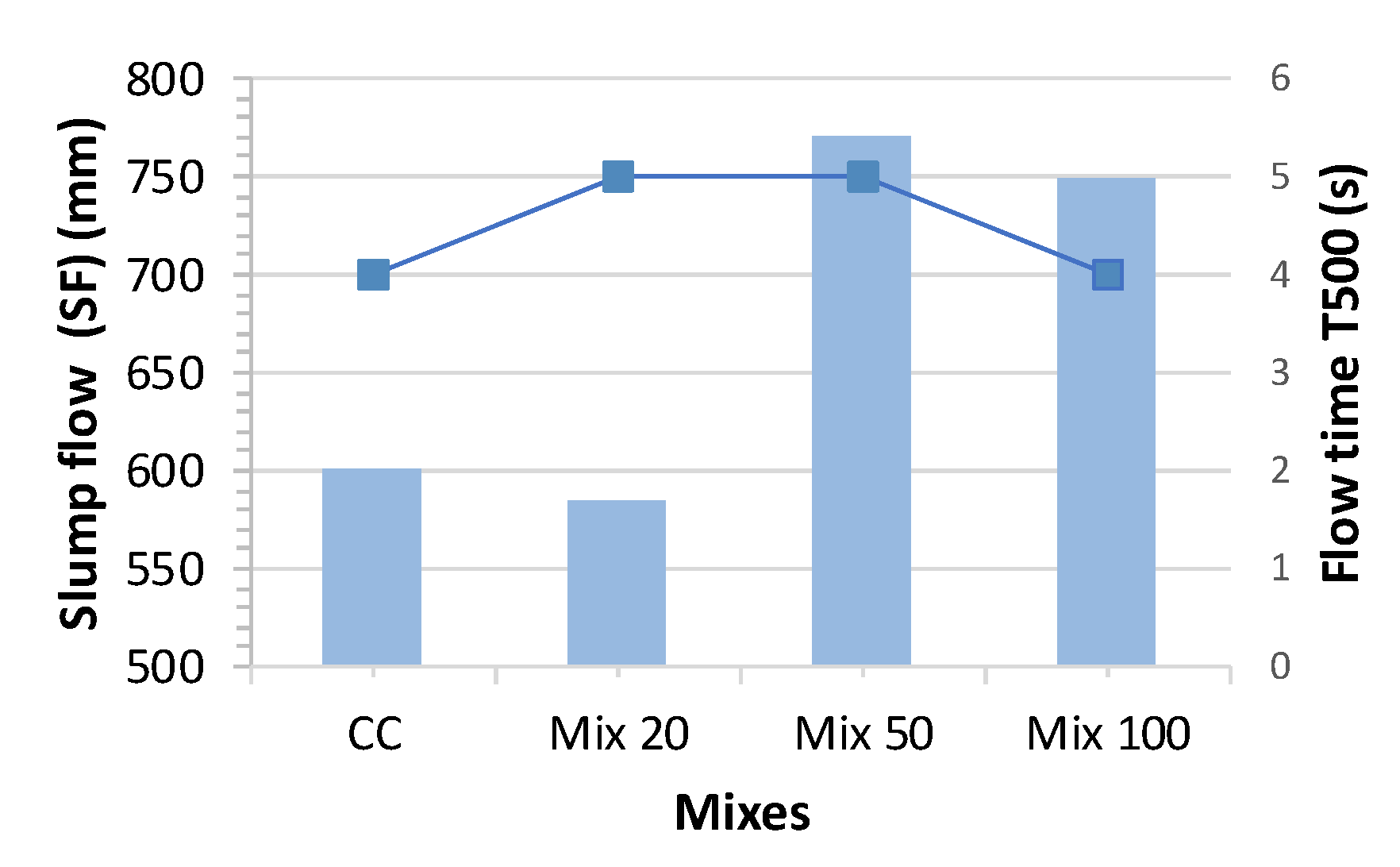
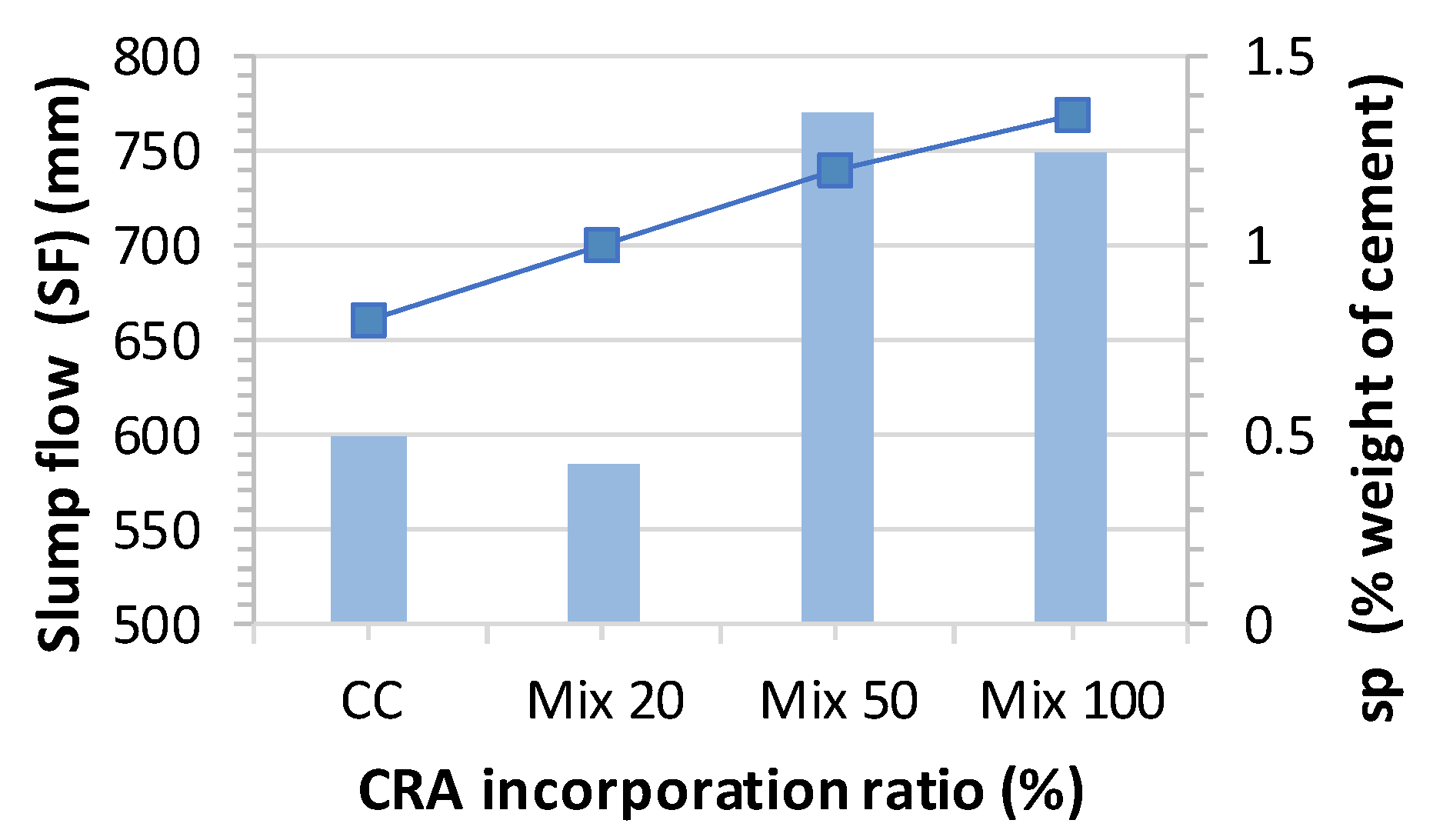
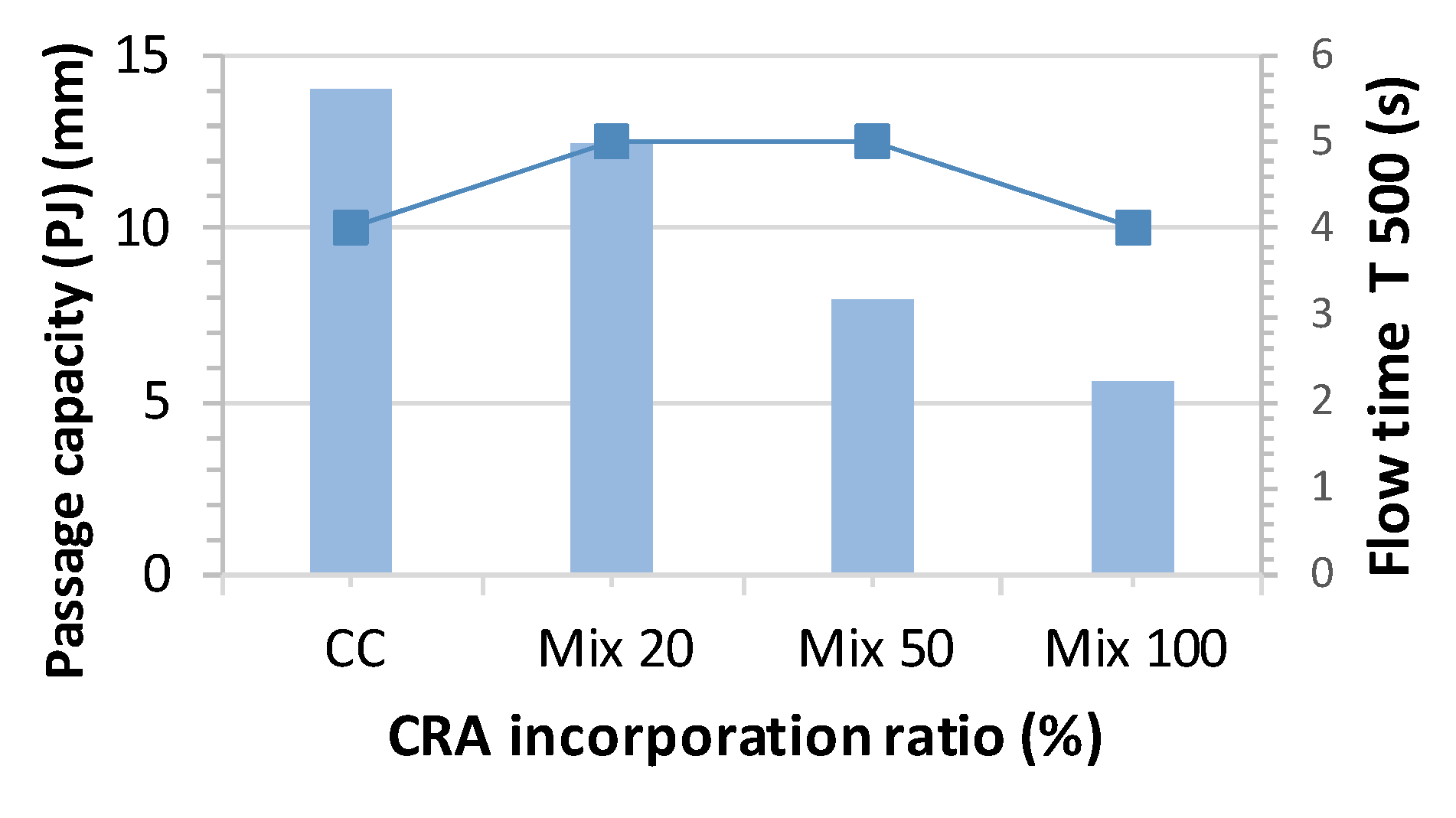
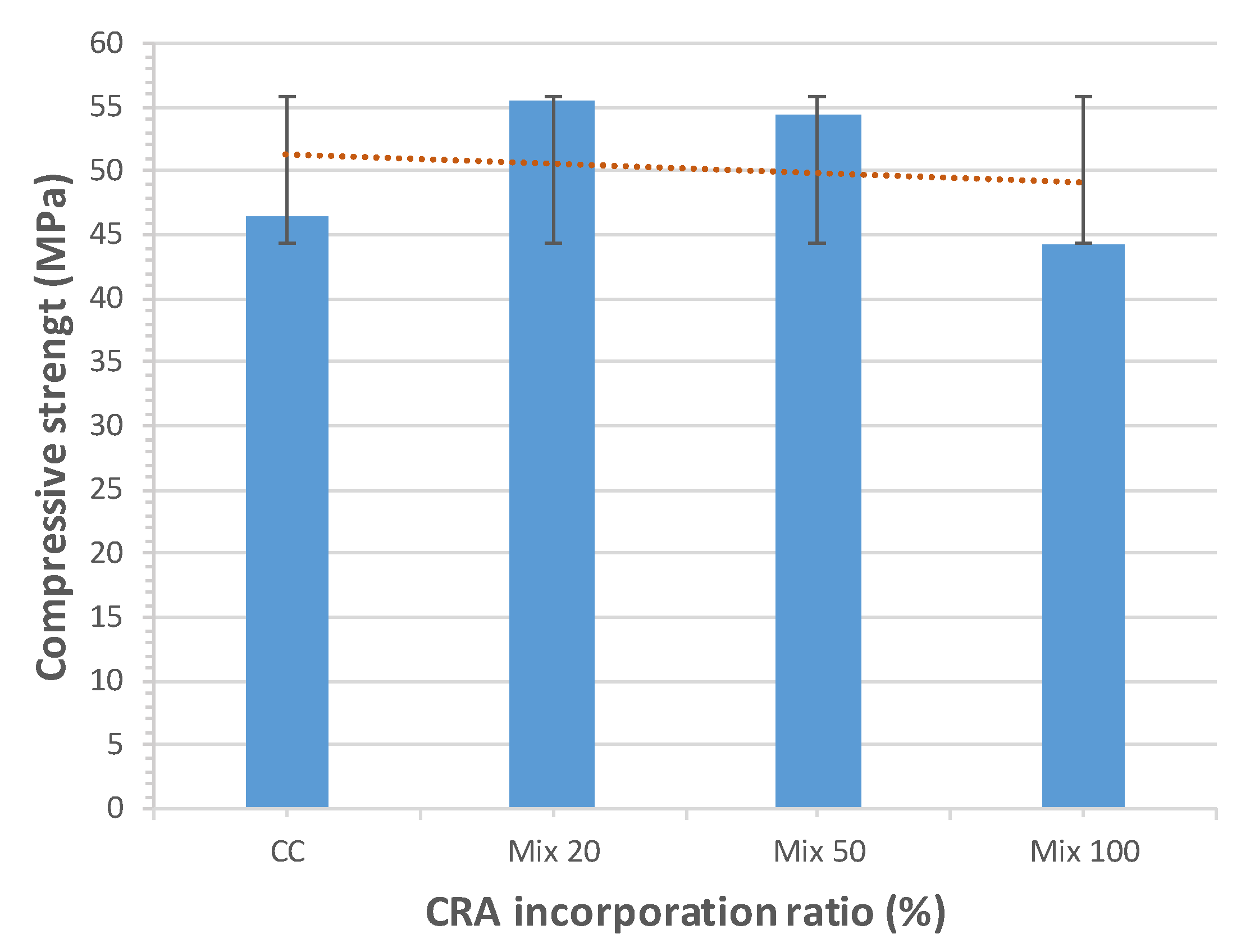
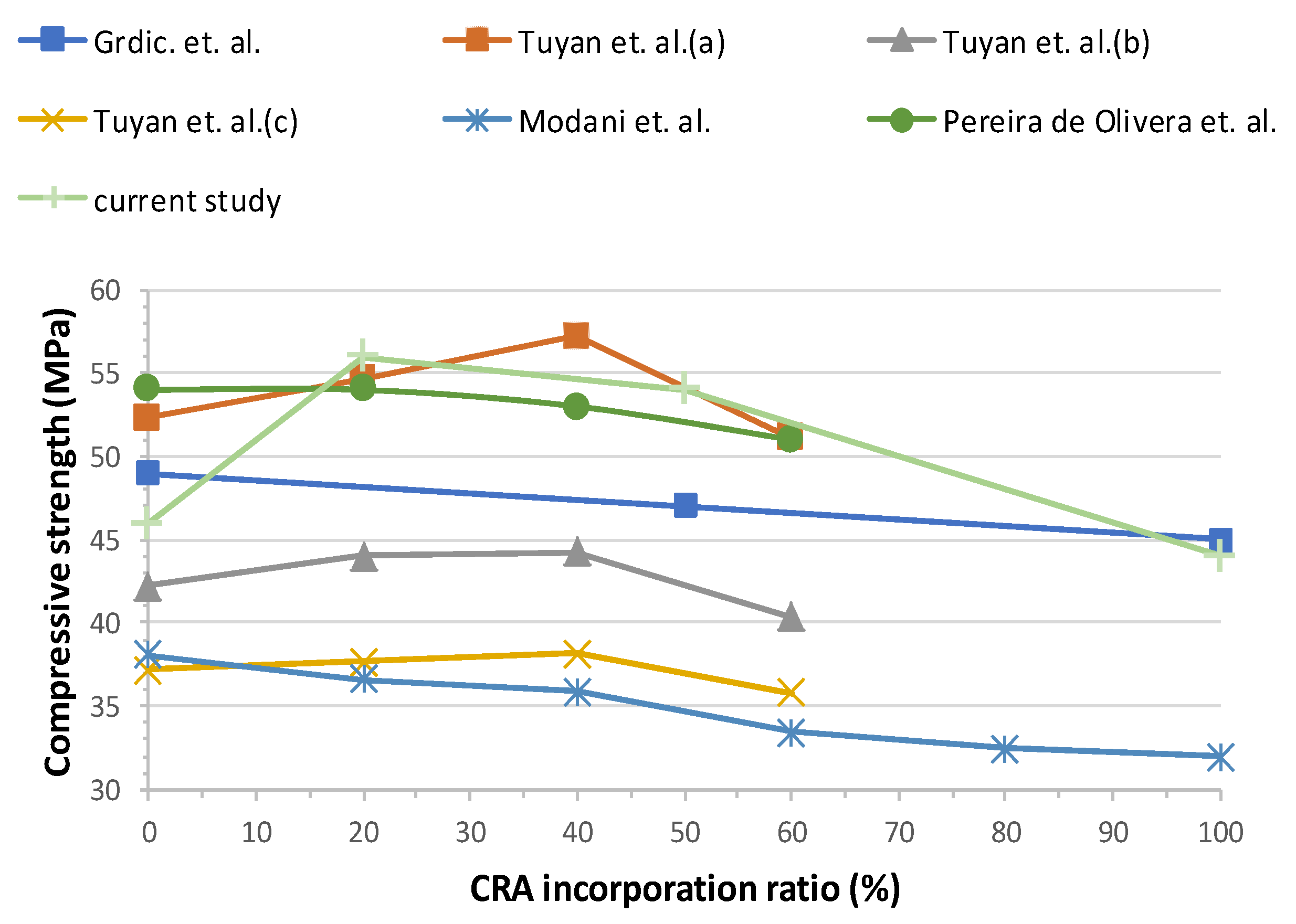
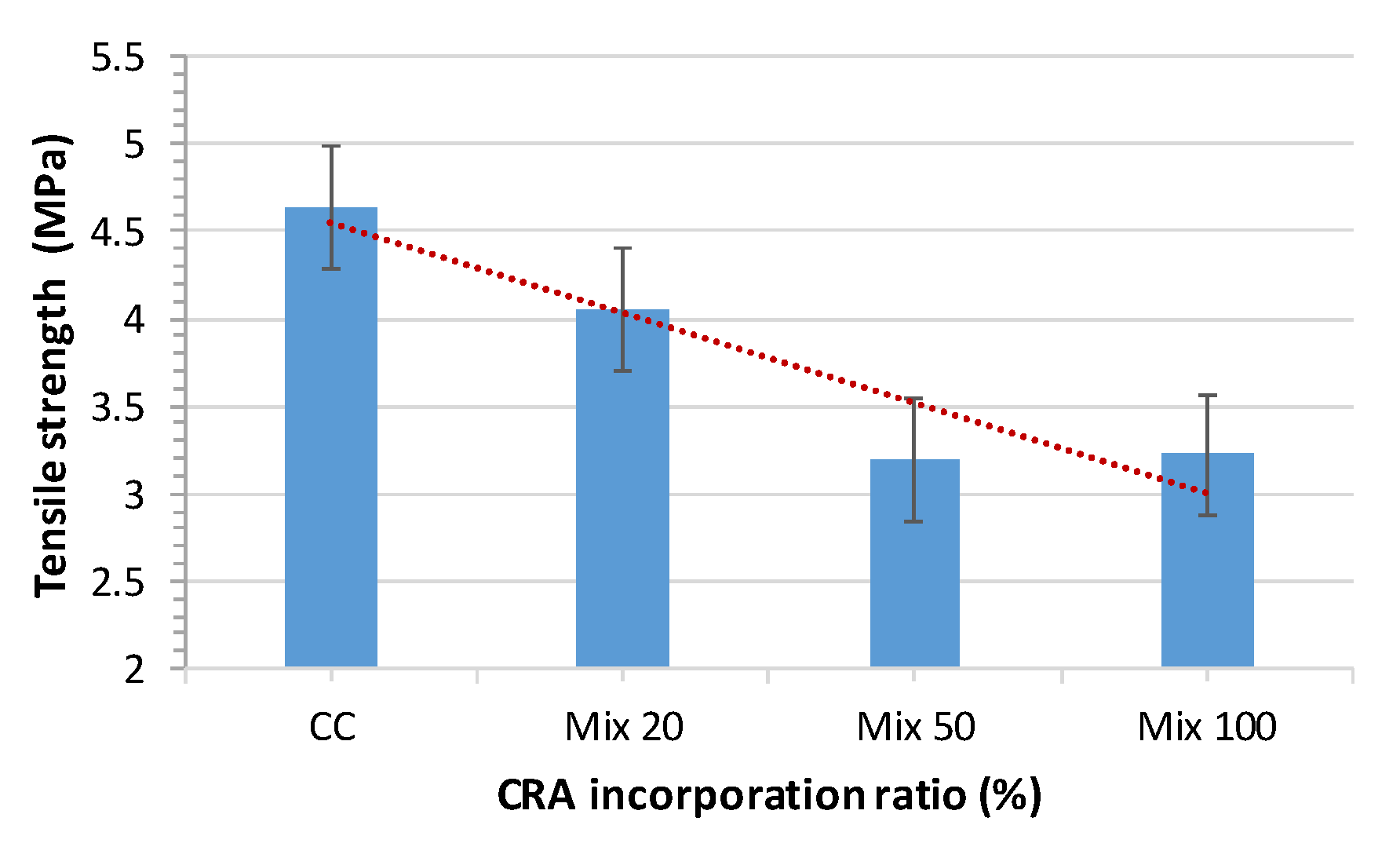
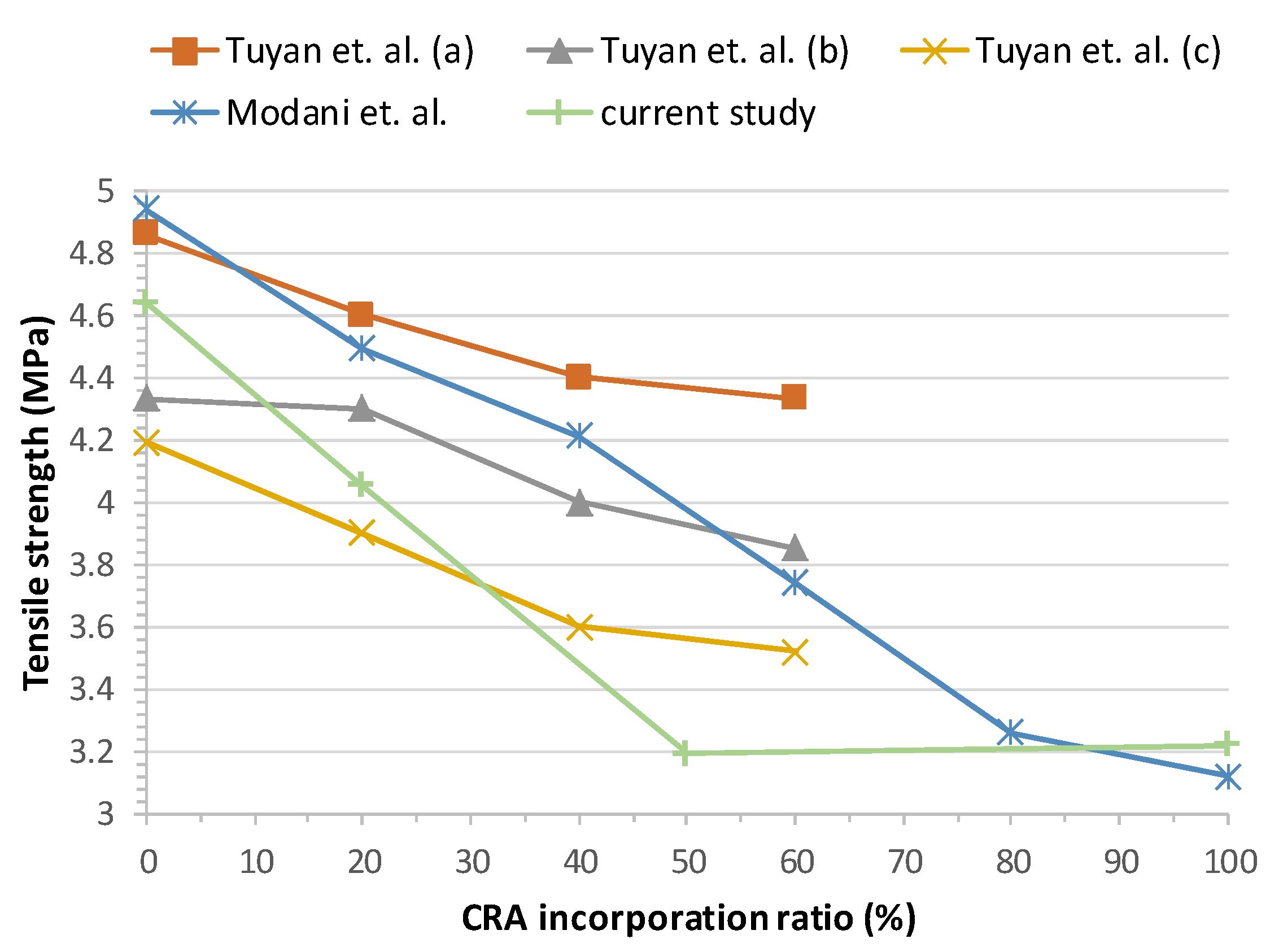

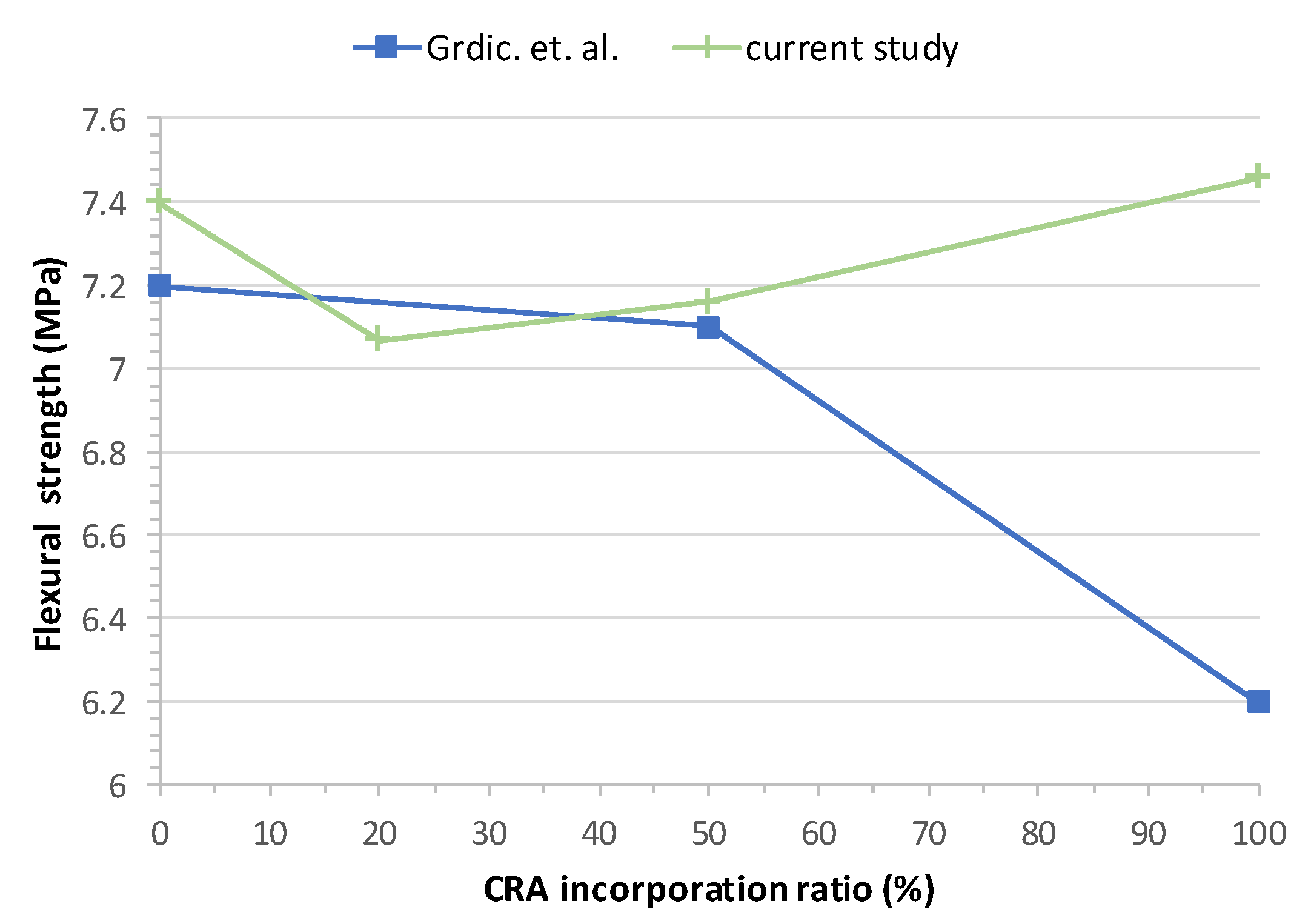
| Chemical Composition | Value (wt.%) | Limit (wt.%) [39] |
| Clinker (SiO2, Fe2O3, Al2O3, CaO, MgO and SO3) | 54 | 35–64 |
| Blast-furnace slag | 41 | 36–65 |
| Minor components | 5 | ≤5 |
| LOI (Loss on ignition) | 1.5 | ≤5 |
| Physical Characteristics | ||
| Le Chatelier (mm) | 0.1 | ≤5 |
| Setting time initial (min) | 210 | ≥60 |
| Setting time final (min) | 260 | ≥60 |
| Mechanical Characteristics | ||
| Compressive strength (MPa) 2 days | 20.1 | ≥13.5 |
| Compressive strength (MPa) 28 days | 56.6 | ≤42.5 and ≤62.5 |
| Chemical Composition | Filler Value (wt.%) | CNA 1 Value (wt.%) | FNA 2 Value (wt.%) |
|---|---|---|---|
| SiO2 | 6% | 98.09% | 95.31% |
| Al2O3 | 1.2% | 1.17% | 2.24% |
| Fe2O3 | 0.69% | 0.27% | 1.06% |
| CaO | 52.5% | 0.05% | 0.16% |
| MgO | 1.4% | - | - |
| K2O | - | 0.14% | 0.38% |
| TiO2 | - | - | 0.17% |
| MnO | - | - | 0.05% |
| CuO | - | - | 0.03% |
| ZrO2 | - | - | 0.03% |
| LOI (Loss on ignition) | 38.21% | 0.28% | 0.57% |
| Parameter | Standard | Value | Limit EHE-08 [31] |
|---|---|---|---|
| Composition (%) | EN 933-1:2012 [41] | ||
| Fl (floating particles) (%) | 0 | ≤1 | |
| X (gypsum and impurities) (%) | 0.04 | ≤1 | |
| Rc (concrete) (%) | 70.7 | - | |
| Ru (natural stone) (%) | 27 | - | |
| Rb (bricks and tiles) (%) | 2.3 | ≤5 | |
| Ra (bituminous mat.) (%) | 0 | ≤1 | |
| Rg (glass) (%) | 0 | ≤1 | |
| Flakiness index (%) | EN 933-3:2012 [42] | 5.7 | ≤35 |
| Density and absorption | EN 1097-6:2014 [43] | ||
| Pa (apparent density) (Mg/m3) | 2.52 | - | |
| Pod (oven-dry density) (Mg/m3) | 1.94 | - | |
| Pssd (saturated surface dry density) (Mg/m3) | 2.17 | - | |
| WA24 (%) | 4.8 | ≤5 | |
| Los Angeles coefficient (%) | EN 1097-2:2010 [44] | 36 | ≤40 |
| Parameter | Standard | Value | Limit EHE-08 [31] |
|---|---|---|---|
| Flakiness index (%) | EN 933-3:2012 [42] | 3.6 | ≤ 35 |
| Density and absorption | EN 1097-6:2014 [43] | ||
| Pa (apparent density) (Mg/m3) | 3.01 | - | |
| Prd (oven-dry density) (Mg/m3) | 2.66 | - | |
| Pssd (saturated surface dry density) (Mg/m3) | 2.78 | - | |
| WA24 (%) | 4.3 | ≤ 5 | |
| Los Angeles coefficient (%) | EN 1097-2:2010 [44] | 34 | ≤ 40 |
| Mixes | Coarse Natural Aggregate (%) | Coarse Recycled Aggregate (%) |
|---|---|---|
| CC 1 | 100% | 0% |
| Mix 20 2 | 80% | 20% |
| Mix 50 3 | 50% | 50% |
| Mix 100 4 | 0% | 100% |
| Content (m3) | CC 1 | Mix 20 2 | Mix 50 3 | Mix 100 4 |
|---|---|---|---|---|
| Cement (kg) | 400 | 400 | 400 | 400 |
| Lime filler (kg) | 58 | 58 | 58 | 58 |
| Water (kg) | 190 | 190 | 190 | 190 |
| Natural sand (kg) | 904 | 904 | 904 | 904 |
| Coarse natural aggregate (kg) | 700 | 560 | 350 | 0 |
| Coarse recycled aggregate (kg) | 0 | 140 | 350 | 700 |
| Superplasticizer (% weight of cement) | 0.8 | 1 | 1.2 | 1.35 |
| W/C ratio | 0.47 | 0.47 | 0.47 | 0.47 |
| Mix | Flow | J-Ring | |||
|---|---|---|---|---|---|
| T500 (s) 1 | Limit EHE-08 [31] | SF (mm) 2 | Limit EHE-08 [31] | PJ (mm) 3 | |
| CC | 4 4 | ≤8 ≤8 | 600 600 | 550 ≤ SF ≤ 850 550 ≤ SF ≤ 850 | 14 14 |
| Mix 20 | 5 | ≤8 | 590 | 550 ≤ SF ≤ 850 | 15 |
| 5 | ≤8 | 580 | 550 ≤ SF ≤ 850 | 10.25 | |
| Mix 50 | 5 | ≤8 | 770 | 550 ≤ SF ≤ 850 | 11 |
| 5 | ≤8 | 780 | 550 ≤ SF ≤ 850 | 5.3 | |
| Mix 100 | 4 | ≤8 | 730 | 550 ≤ SF ≤ 850 | 5.6 |
| 4 | ≤8 | 770 | 550 ≤ SF ≤ 850 | 5.5 | |
© 2020 by the authors. Licensee MDPI, Basel, Switzerland. This article is an open access article distributed under the terms and conditions of the Creative Commons Attribution (CC BY) license (http://creativecommons.org/licenses/by/4.0/).
Share and Cite
Martínez-García, R.; Guerra-Romero, M.I.; Morán-del Pozo, J.M.; Brito, J.d.; Juan-Valdés, A. Recycling Aggregates for Self-Compacting Concrete Production: A Feasible Option. Materials 2020, 13, 868. https://doi.org/10.3390/ma13040868
Martínez-García R, Guerra-Romero MI, Morán-del Pozo JM, Brito Jd, Juan-Valdés A. Recycling Aggregates for Self-Compacting Concrete Production: A Feasible Option. Materials. 2020; 13(4):868. https://doi.org/10.3390/ma13040868
Chicago/Turabian StyleMartínez-García, Rebeca, M. Ignacio Guerra-Romero, Julia M. Morán-del Pozo, Jorge de Brito, and Andrés Juan-Valdés. 2020. "Recycling Aggregates for Self-Compacting Concrete Production: A Feasible Option" Materials 13, no. 4: 868. https://doi.org/10.3390/ma13040868
APA StyleMartínez-García, R., Guerra-Romero, M. I., Morán-del Pozo, J. M., Brito, J. d., & Juan-Valdés, A. (2020). Recycling Aggregates for Self-Compacting Concrete Production: A Feasible Option. Materials, 13(4), 868. https://doi.org/10.3390/ma13040868





